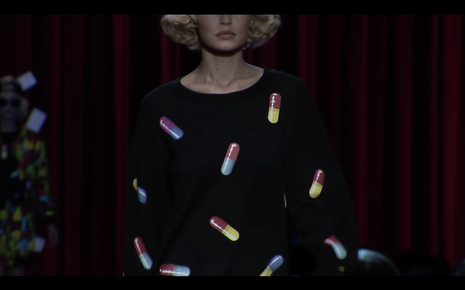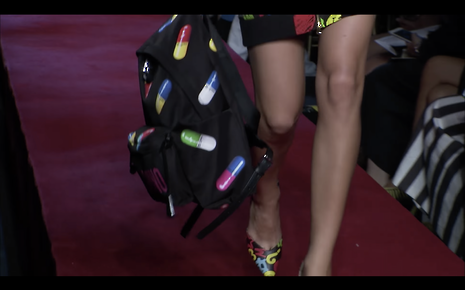Drug abuse is the new black
Emma Walsh thinks about the obscure message behind Moschino’s latest collection

Moschino’s Spring/Summer 2017 ‘Capsule’ Collection inspired by the packaging of over-the-counter medication has been highly controversial, especially in the US, for frivolously making drug abuse a trend. Fashion is supposed to be leading edge and, today more than ever, political. However, is this glamorising of mental illness and drug abuse a step too far? Are their designer bags shaped like pill cases and clothes plastered with pill prints making the abuse of prescription drugs ‘trendy’?
Moschino is a billion-dollar company. But is it making this money by buying into the glorification and celebration of life-threatening illnesses to increase its profits further? Fashion is fun. The price tags of designer brands may be excessive, but the consumers do feel they profit from their purchases. But selling fashion items such as a £460 clutch bag resembling painkillers or a £540 shoulder bag that looks like an oversized pill container, and thus endorsing drug abuse for profit is not only exploitative, but dangerous.
Many, especially in the US view the collection as trivialising a serious issue. Deaths from overdose on prescription opioids have quadrupled since 1999 and almost two million Americans abused or were dependent on prescription opioids in 2014. This is a serious epidemic affecting millions of lives.
Moschino, however, defends the garments and accessories as reflecting “Jeremy Scott’s fun, provocative language” present throughout the brand’s collections. But is this collection a step too far? Nordstrum, a major US department store, clearly thinks so as they will no longer be selling the controversial collection after protests from many doctors, addiction specialists and parents of overdose victims. Jeremy Scott claims “fashion is the only drug I do”, but for others it is not. Moschino have called the negative interpretation of the collection “a misunderstanding”. But if the collection is supposed to be tongue-in-cheek, what is the joke? Are those protesting not elite and fashionable enough to understand the punch line?

However, while we can hope that the initial idea wasn’t to promote drug addiction, what was the purpose? It could be a comment on the American obsession with prescription drugs, in keeping with Moschino’s provocative collections. But does this collection start a conversation, reducing the stigma surrounding mental illness, or is it an offensive glorification of drug abuse? Are these bold and bright creations a step too far, or the beginning of the future for edgy fashion?
Quite arguably, by making something deadly fashionable, this undermines the seriousness of the issue for so many people. What about the parents whose children have died from a drug overdose? Or the person whose life has been ruined by addiction? The romanticising of mental illness in the arts is an increasing issue. It is becoming fashionable to be depressed or anxious; meanwhile there are people struggling to get through the day. The stigmatisation of mental health needs to be overcome. But perhaps the way to do this is not through encouraging damaging behaviours that will ultimately lead to a spiral of decline in the mental health of Moschino’s consumers.
Not only is the fashion industry largely blamed for eating disorders, but is drug abuse now being advertised as the new ‘skinny’? Are pills the new black, and death by drug overdose the new death by starvation? Fashion should push the boundaries, but endorsing drug abuse to a largely young demographic seems, for a designer brand, to be in quite poor taste
 News / Cambridge academics stand out in King’s 2026 Honours List2 January 2026
News / Cambridge academics stand out in King’s 2026 Honours List2 January 2026 Interviews / You don’t need to peak at Cambridge, says Robin Harding31 December 2025
Interviews / You don’t need to peak at Cambridge, says Robin Harding31 December 2025 Comment / What happened to men at Cambridge?31 December 2025
Comment / What happened to men at Cambridge?31 December 2025 Features / “It’s a momentary expression of rage”: reforming democracy from Cambridge4 January 2026
Features / “It’s a momentary expression of rage”: reforming democracy from Cambridge4 January 2026 News / Varsity’s biggest stories of 202531 December 2025
News / Varsity’s biggest stories of 202531 December 2025









